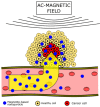Magnetite Nanoparticles in Magnetic Hyperthermia and Cancer Therapies: Challenges and Perspectives
- PMID: 35683663
- PMCID: PMC9182445
- DOI: 10.3390/nano12111807
Magnetite Nanoparticles in Magnetic Hyperthermia and Cancer Therapies: Challenges and Perspectives
Abstract
Until now, strategies used to treat cancer are imperfect, and this generates the need to search for better and safer solutions. The biggest issue is the lack of selective interaction with neoplastic cells, which is associated with occurrence of side effects and significantly reduces the effectiveness of therapies. The use of nanoparticles in cancer can counteract these problems. One of the most promising nanoparticles is magnetite. Implementation of this nanoparticle can improve various treatment methods such as hyperthermia, targeted drug delivery, cancer genotherapy, and protein therapy. In the first case, its feature makes magnetite useful in magnetic hyperthermia. Interaction of magnetite with the altered magnetic field generates heat. This process results in raised temperature only in a desired part of a patient body. In other therapies, magnetite-based nanoparticles could serve as a carrier for various types of therapeutic load. The magnetic field would direct the drug-related magnetite nanoparticles to the pathological site. Therefore, this material can be used in protein and gene therapy or drug delivery. Since the magnetite nanoparticle can be used in various types of cancer treatment, they are extensively studied. Herein, we summarize the latest finding on the applicability of the magnetite nanoparticles, also addressing the most critical problems faced by smart nanomedicine in oncological therapies.
Keywords: hyperthermia; magnetite nanoparticles; smart nanomedicine.
Conflict of interest statement
The authors declare no conflict of interest.
Figures


Similar articles
-
In vitro anti-cancer efficacy of multi-functionalized magnetite nanoparticles combining alternating magnetic hyperthermia in glioblastoma cancer cells.Mater Sci Eng C Mater Biol Appl. 2019 Aug;101:575-587. doi: 10.1016/j.msec.2019.04.007. Epub 2019 Apr 6. Mater Sci Eng C Mater Biol Appl. 2019. PMID: 31029351
-
Optimization Study on Specific Loss Power in Superparamagnetic Hyperthermia with Magnetite Nanoparticles for High Efficiency in Alternative Cancer Therapy.Nanomaterials (Basel). 2020 Dec 26;11(1):40. doi: 10.3390/nano11010040. Nanomaterials (Basel). 2020. PMID: 33375292 Free PMC article.
-
Cancer hyperthermia using magnetic nanoparticles.Biotechnol J. 2011 Nov;6(11):1342-7. doi: 10.1002/biot.201100045. Epub 2011 Aug 26. Biotechnol J. 2011. PMID: 22069094 Review.
-
A review on hyperthermia via nanoparticle-mediated therapy.Bull Cancer. 2017 May;104(5):452-461. doi: 10.1016/j.bulcan.2017.02.003. Epub 2017 Apr 3. Bull Cancer. 2017. PMID: 28385267 Review.
-
Comparative evaluation of magnetic hyperthermia performance and biocompatibility of magnetite and novel Fe-doped hardystonite nanoparticles for potential bone cancer therapy.Mater Sci Eng C Mater Biol Appl. 2019 May;98:930-938. doi: 10.1016/j.msec.2019.01.038. Epub 2019 Jan 9. Mater Sci Eng C Mater Biol Appl. 2019. PMID: 30813100
Cited by
-
A Review of Advanced Multifunctional Magnetic Nanostructures for Cancer Diagnosis and Therapy Integrated into an Artificial Intelligence Approach.Pharmaceutics. 2023 Mar 7;15(3):868. doi: 10.3390/pharmaceutics15030868. Pharmaceutics. 2023. PMID: 36986729 Free PMC article. Review.
-
Breast Cancer Treatment Using the Magneto-Hyperthermia Technique Associated with Omega-3 Polyunsaturated Fatty Acids' Supplementation and Physical Training.Pharmaceutics. 2024 Feb 22;16(3):310. doi: 10.3390/pharmaceutics16030310. Pharmaceutics. 2024. PMID: 38543205 Free PMC article.
-
Iron Oxide Nanoparticles in Cancer Treatment: Cell Responses and the Potency to Improve Radiosensitivity.Pharmaceutics. 2023 Sep 30;15(10):2406. doi: 10.3390/pharmaceutics15102406. Pharmaceutics. 2023. PMID: 37896166 Free PMC article. Review.
-
Multifunctional Polymeric Biodegradable and Biocompatible Coatings Based on Silver Nanoparticles: A Comparative In Vitro Study on Their Cytotoxicity towards Cancer and Normal Cell Lines of Cytostatic Drugs versus Essential-Oil-Loaded Nanoparticles and on Their Antimicrobial and Antibiofilm Activities.Pharmaceutics. 2023 Jul 4;15(7):1882. doi: 10.3390/pharmaceutics15071882. Pharmaceutics. 2023. PMID: 37514068 Free PMC article.
-
Magnetic Nanoparticle Coating Decreases the Senescence and Increases the Targeting Potential of Fibroblasts and Adipose-Derived Mesenchymal Stem Cells.ACS Omega. 2023 Jun 22;8(26):23953-23963. doi: 10.1021/acsomega.3c02449. eCollection 2023 Jul 4. ACS Omega. 2023. PMID: 37426224 Free PMC article.
References
Publication types
LinkOut - more resources
Full Text Sources

